Yujie Zhou
$\text{G}^2$RPO: Granular GRPO for Precise Reward in Flow Models
Oct 02, 2025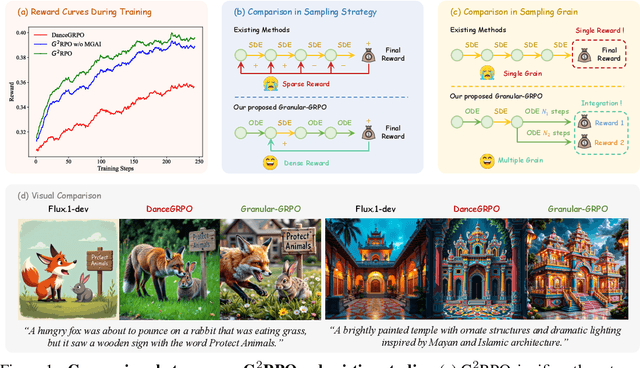
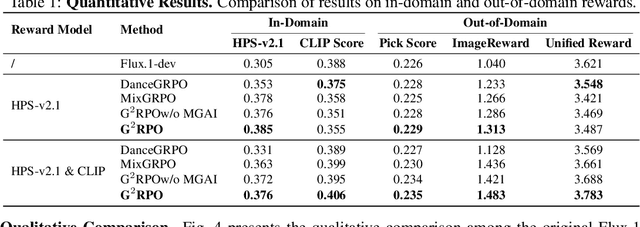
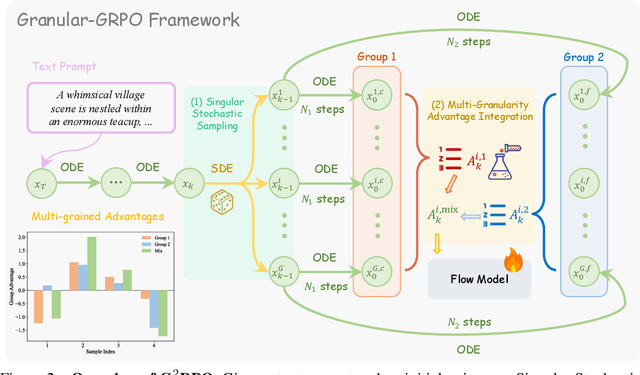

Abstract:The integration of online reinforcement learning (RL) into diffusion and flow models has recently emerged as a promising approach for aligning generative models with human preferences. Stochastic sampling via Stochastic Differential Equations (SDE) is employed during the denoising process to generate diverse denoising directions for RL exploration. While existing methods effectively explore potential high-value samples, they suffer from sub-optimal preference alignment due to sparse and narrow reward signals. To address these challenges, we propose a novel Granular-GRPO ($\text{G}^2$RPO ) framework that achieves precise and comprehensive reward assessments of sampling directions in reinforcement learning of flow models. Specifically, a Singular Stochastic Sampling strategy is introduced to support step-wise stochastic exploration while enforcing a high correlation between the reward and the injected noise, thereby facilitating a faithful reward for each SDE perturbation. Concurrently, to eliminate the bias inherent in fixed-granularity denoising, we introduce a Multi-Granularity Advantage Integration module that aggregates advantages computed at multiple diffusion scales, producing a more comprehensive and robust evaluation of the sampling directions. Experiments conducted on various reward models, including both in-domain and out-of-domain evaluations, demonstrate that our $\text{G}^2$RPO significantly outperforms existing flow-based GRPO baselines,highlighting its effectiveness and robustness.
Pref-GRPO: Pairwise Preference Reward-based GRPO for Stable Text-to-Image Reinforcement Learning
Aug 28, 2025Abstract:Recent advancements highlight the importance of GRPO-based reinforcement learning methods and benchmarking in enhancing text-to-image (T2I) generation. However, current methods using pointwise reward models (RM) for scoring generated images are susceptible to reward hacking. We reveal that this happens when minimal score differences between images are amplified after normalization, creating illusory advantages that drive the model to over-optimize for trivial gains, ultimately destabilizing the image generation process. To address this, we propose Pref-GRPO, a pairwise preference reward-based GRPO method that shifts the optimization objective from score maximization to preference fitting, ensuring more stable training. In Pref-GRPO, images are pairwise compared within each group using preference RM, and the win rate is used as the reward signal. Extensive experiments demonstrate that PREF-GRPO differentiates subtle image quality differences, providing more stable advantages and mitigating reward hacking. Additionally, existing T2I benchmarks are limited by coarse evaluation criteria, hindering comprehensive model assessment. To solve this, we introduce UniGenBench, a unified T2I benchmark comprising 600 prompts across 5 main themes and 20 subthemes. It evaluates semantic consistency through 10 primary and 27 sub-criteria, leveraging MLLM for benchmark construction and evaluation. Our benchmarks uncover the strengths and weaknesses of both open and closed-source T2I models and validate the effectiveness of Pref-GRPO.
DiCache: Let Diffusion Model Determine Its Own Cache
Aug 24, 2025


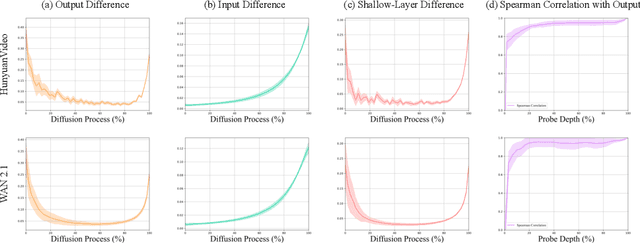
Abstract:Recent years have witnessed the rapid development of acceleration techniques for diffusion models, especially caching-based acceleration methods. These studies seek to answer two fundamental questions: "When to cache" and "How to use cache", typically relying on predefined empirical laws or dataset-level priors to determine the timing of caching and utilizing handcrafted rules for leveraging multi-step caches. However, given the highly dynamic nature of the diffusion process, they often exhibit limited generalizability and fail on outlier samples. In this paper, a strong correlation is revealed between the variation patterns of the shallow-layer feature differences in the diffusion model and those of final model outputs. Moreover, we have observed that the features from different model layers form similar trajectories. Based on these observations, we present DiCache, a novel training-free adaptive caching strategy for accelerating diffusion models at runtime, answering both when and how to cache within a unified framework. Specifically, DiCache is composed of two principal components: (1) Online Probe Profiling Scheme leverages a shallow-layer online probe to obtain a stable prior for the caching error in real time, enabling the model to autonomously determine caching schedules. (2) Dynamic Cache Trajectory Alignment combines multi-step caches based on shallow-layer probe feature trajectory to better approximate the current feature, facilitating higher visual quality. Extensive experiments validate DiCache's capability in achieving higher efficiency and improved visual fidelity over state-of-the-art methods on various leading diffusion models including WAN 2.1, HunyuanVideo for video generation, and Flux for image generation.
The Devil is in the Prompts: Retrieval-Augmented Prompt Optimization for Text-to-Video Generation
Apr 16, 2025Abstract:The evolution of Text-to-video (T2V) generative models, trained on large-scale datasets, has been marked by significant progress. However, the sensitivity of T2V generative models to input prompts highlights the critical role of prompt design in influencing generative outcomes. Prior research has predominantly relied on Large Language Models (LLMs) to align user-provided prompts with the distribution of training prompts, albeit without tailored guidance encompassing prompt vocabulary and sentence structure nuances. To this end, we introduce \textbf{RAPO}, a novel \textbf{R}etrieval-\textbf{A}ugmented \textbf{P}rompt \textbf{O}ptimization framework. In order to address potential inaccuracies and ambiguous details generated by LLM-generated prompts. RAPO refines the naive prompts through dual optimization branches, selecting the superior prompt for T2V generation. The first branch augments user prompts with diverse modifiers extracted from a learned relational graph, refining them to align with the format of training prompts via a fine-tuned LLM. Conversely, the second branch rewrites the naive prompt using a pre-trained LLM following a well-defined instruction set. Extensive experiments demonstrate that RAPO can effectively enhance both the static and dynamic dimensions of generated videos, demonstrating the significance of prompt optimization for user-provided prompts. Project website: \href{https://whynothaha.github.io/Prompt_optimizer/RAPO.html}{GitHub}.
HiFlow: Training-free High-Resolution Image Generation with Flow-Aligned Guidance
Apr 08, 2025Abstract:Text-to-image (T2I) diffusion/flow models have drawn considerable attention recently due to their remarkable ability to deliver flexible visual creations. Still, high-resolution image synthesis presents formidable challenges due to the scarcity and complexity of high-resolution content. To this end, we present HiFlow, a training-free and model-agnostic framework to unlock the resolution potential of pre-trained flow models. Specifically, HiFlow establishes a virtual reference flow within the high-resolution space that effectively captures the characteristics of low-resolution flow information, offering guidance for high-resolution generation through three key aspects: initialization alignment for low-frequency consistency, direction alignment for structure preservation, and acceleration alignment for detail fidelity. By leveraging this flow-aligned guidance, HiFlow substantially elevates the quality of high-resolution image synthesis of T2I models and demonstrates versatility across their personalized variants. Extensive experiments validate HiFlow's superiority in achieving superior high-resolution image quality over current state-of-the-art methods.
Light-A-Video: Training-free Video Relighting via Progressive Light Fusion
Feb 12, 2025
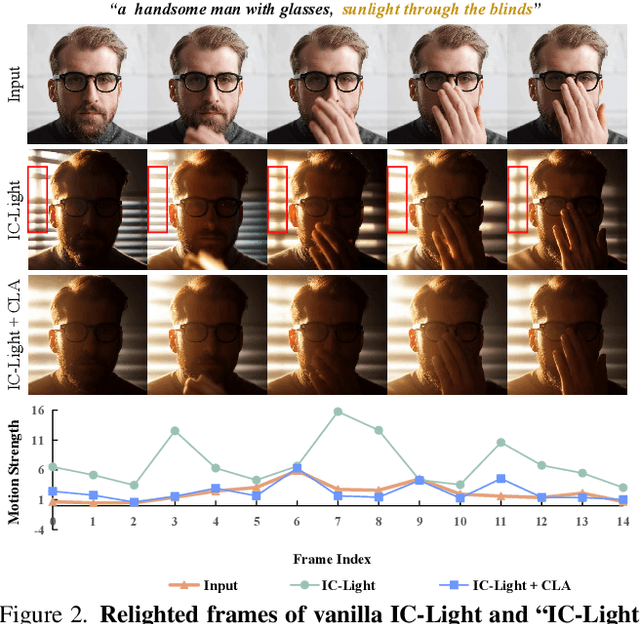
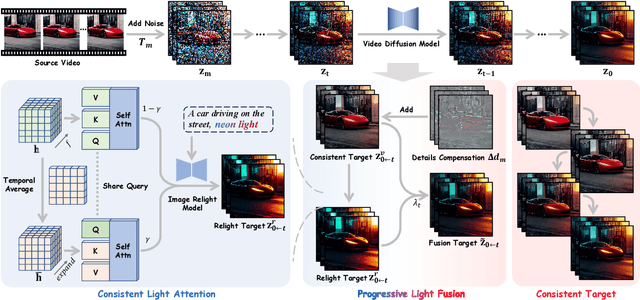
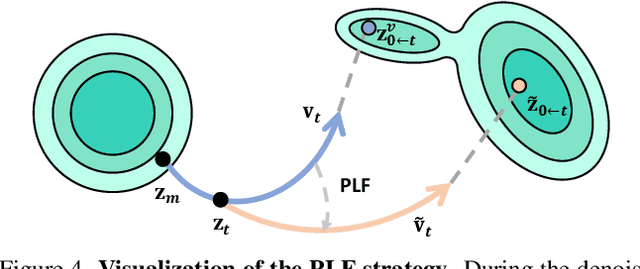
Abstract:Recent advancements in image relighting models, driven by large-scale datasets and pre-trained diffusion models, have enabled the imposition of consistent lighting. However, video relighting still lags, primarily due to the excessive training costs and the scarcity of diverse, high-quality video relighting datasets. A simple application of image relighting models on a frame-by-frame basis leads to several issues: lighting source inconsistency and relighted appearance inconsistency, resulting in flickers in the generated videos. In this work, we propose Light-A-Video, a training-free approach to achieve temporally smooth video relighting. Adapted from image relighting models, Light-A-Video introduces two key techniques to enhance lighting consistency. First, we design a Consistent Light Attention (CLA) module, which enhances cross-frame interactions within the self-attention layers to stabilize the generation of the background lighting source. Second, leveraging the physical principle of light transport independence, we apply linear blending between the source video's appearance and the relighted appearance, using a Progressive Light Fusion (PLF) strategy to ensure smooth temporal transitions in illumination. Experiments show that Light-A-Video improves the temporal consistency of relighted video while maintaining the image quality, ensuring coherent lighting transitions across frames. Project page: https://bujiazi.github.io/light-a-video.github.io/.
Spatio-Temporal Branching for Motion Prediction using Motion Increments
Aug 11, 2023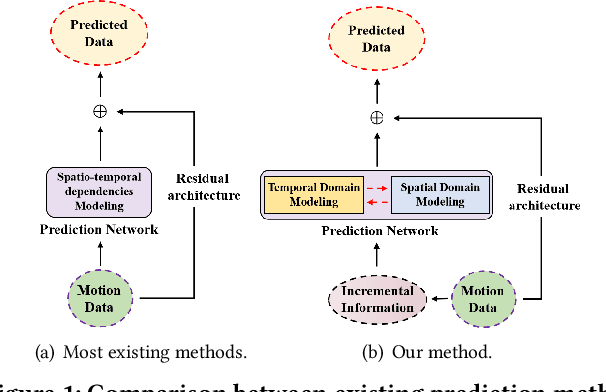
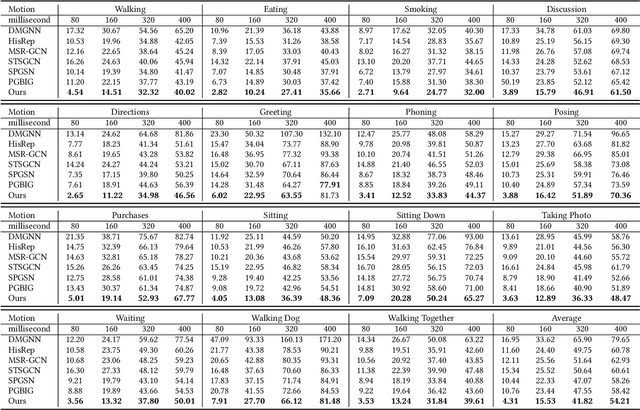
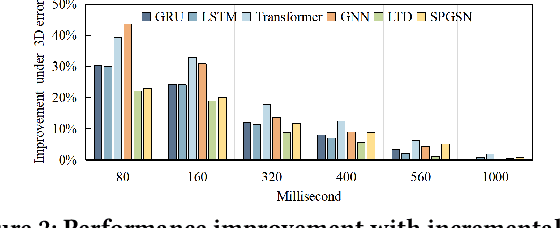

Abstract:Human motion prediction (HMP) has emerged as a popular research topic due to its diverse applications, but it remains a challenging task due to the stochastic and aperiodic nature of future poses. Traditional methods rely on hand-crafted features and machine learning techniques, which often struggle to model the complex dynamics of human motion. Recent deep learning-based methods have achieved success by learning spatio-temporal representations of motion, but these models often overlook the reliability of motion data. Additionally, the temporal and spatial dependencies of skeleton nodes are distinct. The temporal relationship captures motion information over time, while the spatial relationship describes body structure and the relationships between different nodes. In this paper, we propose a novel spatio-temporal branching network using incremental information for HMP, which decouples the learning of temporal-domain and spatial-domain features, extracts more motion information, and achieves complementary cross-domain knowledge learning through knowledge distillation. Our approach effectively reduces noise interference and provides more expressive information for characterizing motion by separately extracting temporal and spatial features. We evaluate our approach on standard HMP benchmarks and outperform state-of-the-art methods in terms of prediction accuracy.
Zero-shot Skeleton-based Action Recognition via Mutual Information Estimation and Maximization
Aug 07, 2023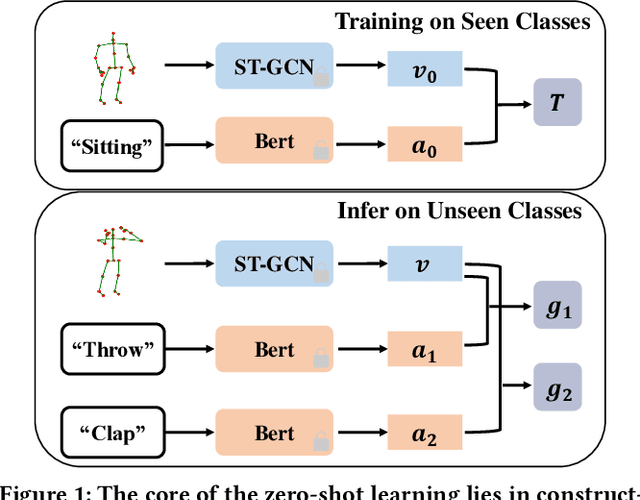

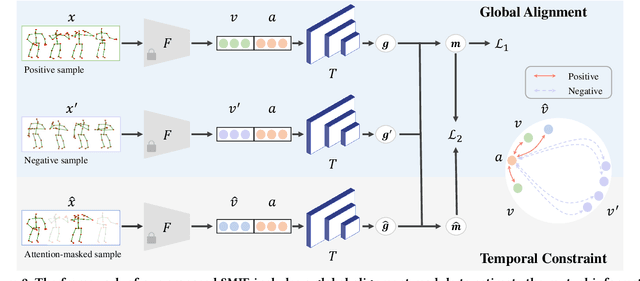
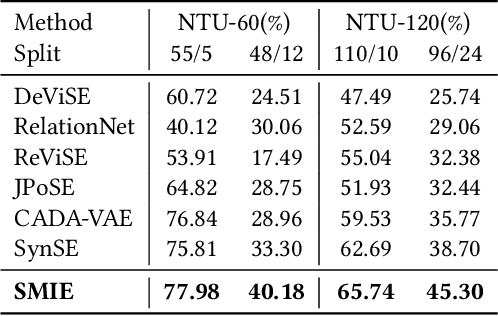
Abstract:Zero-shot skeleton-based action recognition aims to recognize actions of unseen categories after training on data of seen categories. The key is to build the connection between visual and semantic space from seen to unseen classes. Previous studies have primarily focused on encoding sequences into a singular feature vector, with subsequent mapping the features to an identical anchor point within the embedded space. Their performance is hindered by 1) the ignorance of the global visual/semantic distribution alignment, which results in a limitation to capture the true interdependence between the two spaces. 2) the negligence of temporal information since the frame-wise features with rich action clues are directly pooled into a single feature vector. We propose a new zero-shot skeleton-based action recognition method via mutual information (MI) estimation and maximization. Specifically, 1) we maximize the MI between visual and semantic space for distribution alignment; 2) we leverage the temporal information for estimating the MI by encouraging MI to increase as more frames are observed. Extensive experiments on three large-scale skeleton action datasets confirm the effectiveness of our method. Code: https://github.com/YujieOuO/SMIE.
V3Det: Vast Vocabulary Visual Detection Dataset
Apr 07, 2023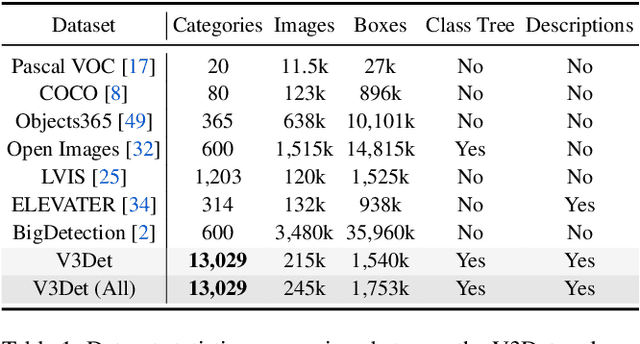
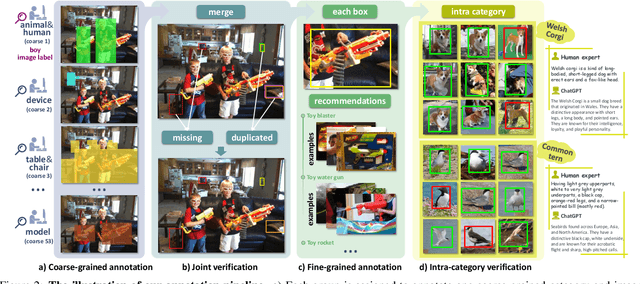
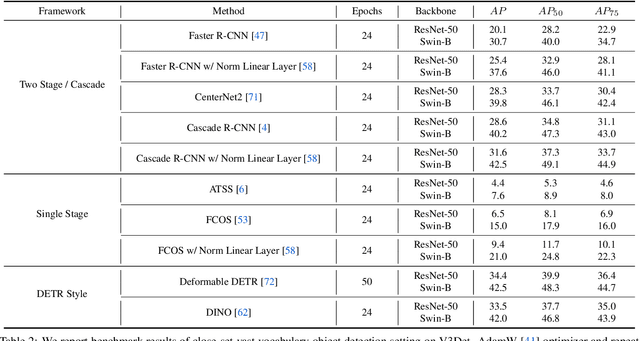

Abstract:Recent advances in detecting arbitrary objects in the real world are trained and evaluated on object detection datasets with a relatively restricted vocabulary. To facilitate the development of more general visual object detection, we propose V3Det, a vast vocabulary visual detection dataset with precisely annotated bounding boxes on massive images. V3Det has several appealing properties: 1) Vast Vocabulary: It contains bounding boxes of objects from 13,029 categories on real-world images, which is 10 times larger than the existing large vocabulary object detection dataset, e.g., LVIS. 2) Hierarchical Category Organization: The vast vocabulary of V3Det is organized by a hierarchical category tree which annotates the inclusion relationship among categories, encouraging the exploration of category relationships in vast and open vocabulary object detection. 3) Rich Annotations: V3Det comprises precisely annotated objects in 245k images and professional descriptions of each category written by human experts and a powerful chatbot. By offering a vast exploration space, V3Det enables extensive benchmarks on both vast and open vocabulary object detection, leading to new observations, practices, and insights for future research. It has the potential to serve as a cornerstone dataset for developing more general visual perception systems.
Self-supervised Action Representation Learning from Partial Spatio-Temporal Skeleton Sequences
Feb 22, 2023


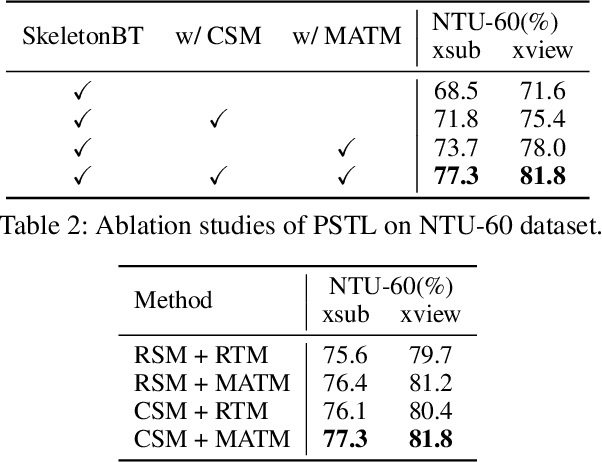
Abstract:Self-supervised learning has demonstrated remarkable capability in representation learning for skeleton-based action recognition. Existing methods mainly focus on applying global data augmentation to generate different views of the skeleton sequence for contrastive learning. However, due to the rich action clues in the skeleton sequences, existing methods may only take a global perspective to learn to discriminate different skeletons without thoroughly leveraging the local relationship between different skeleton joints and video frames, which is essential for real-world applications. In this work, we propose a Partial Spatio-Temporal Learning (PSTL) framework to exploit the local relationship from a partial skeleton sequences built by a unique spatio-temporal masking strategy. Specifically, we construct a negative-sample-free triplet steam structure that is composed of an anchor stream without any masking, a spatial masking stream with Central Spatial Masking (CSM), and a temporal masking stream with Motion Attention Temporal Masking (MATM). The feature cross-correlation matrix is measured between the anchor stream and the other two masking streams, respectively. (1) Central Spatial Masking discards selected joints from the feature calculation process, where the joints with a higher degree of centrality have a higher possibility of being selected. (2) Motion Attention Temporal Masking leverages the motion of action and remove frames that move faster with a higher possibility. Our method achieves SOTA performance on NTU-60, NTU-120 and PKU-MMD under various downstream tasks. A practical evaluation is performed where some skeleton joints are lost in downstream tasks. In contrast to previous methods that suffer from large performance drops, our PSTL can still achieve remarkable results, validating the robustness of our method. Code: https://github.com/YujieOuO/PSTL.git.
 Add to Chrome
Add to Chrome Add to Firefox
Add to Firefox Add to Edge
Add to Edge